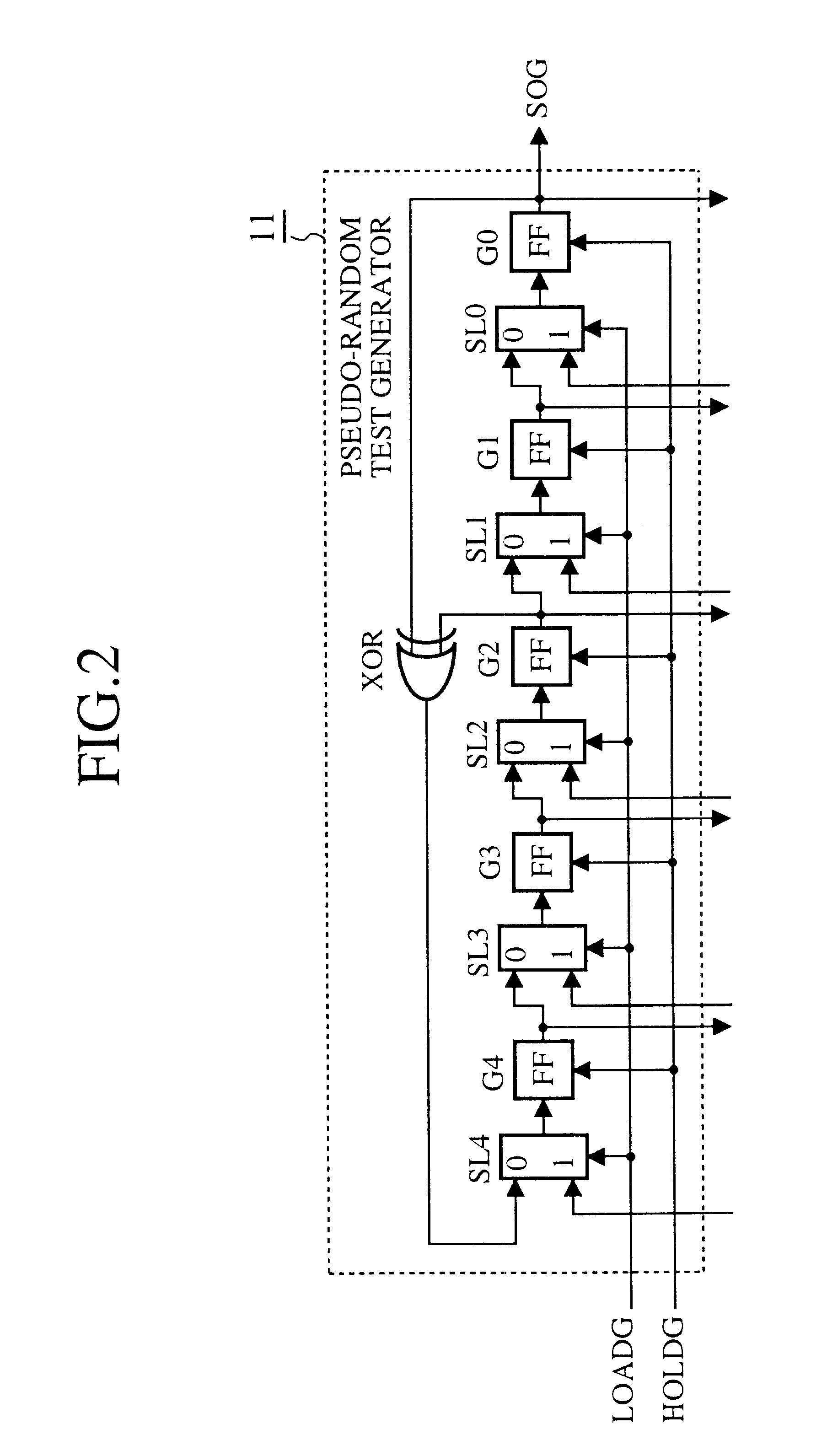Electronic system with self-test function and simulation circuit for electronic system
a technology of electronic system and simulation circuit, which is applied in the direction of instruments, measurement devices, computing, etc., can solve the problems of considerable cost and computer cost of logical simulation
- Summary
- Abstract
- Description
- Claims
- Application Information
AI Technical Summary
Problems solved by technology
Method used
Image
Examples
embodiment 1
FIG. 1 is a block diagram showing an electronic system with a self-test function in accordance with the present invention. In FIG. 1, the reference numeral 11 designates a pseudo-random test pattern generator for serially generating data constituting a pseudo-random test pattern; 12 designates a temporary register for storing, when the pseudo-random test pattern generator 11 starts the serial output of the data constituting the pseudo-random test pattern, a pseudo-random test pattern which is shifted by one bit; 13 designates a scan-path circuit that acquires a pseudo-random test pattern by serially loading the data serially output from the pseudo-random test pattern generator 11, and supplies a tested circuit 14 with the pseudo-random test pattern in parallel, and that receives an operation result of the tested circuit 14 in parallel, and serially outputs data constituting the operation result. The scan-path circuit 13 is a circuit similar to the conventional scan-path circuit 2 as...
embodiment 2
Although the number of the output terminals of the tested circuit 14 is identical to the number of the stages of the scan flip-flops SFF0-SFF8 constituting the scan-path circuit 13 in the foregoing embodiment 1, this is not essential. For example, when the number of the output terminals of the tested circuit 14 is less than the number of the stages of the flip-flops constituting the scan-path circuit 13 as shown in FIG. 9, the scan-path circuit 13 can be configured as follows.
More specifically, flip-flops RFF6-RFF8 in the scan-path circuit 13, which are not connected to the output terminals of the tested circuit 14, can be configured such that they load "0" (fixed value) when the scan-path circuit 13 loads the operation result of the tested circuit 14 in parallel (when the signal SM=0, AND circuits constituting the flip-flops RFF6-RFF8 always output "0").
Thus, the simulation system corresponding to the electronic system as shown in FIG. 9 can be configured as shown in FIG. 10. Since...
embodiment 3
Although the flip-flops RFF6-RFF8 which are not connected to the output terminals of the tested circuit 14 are provided in initial stages of the scan-path circuit 13 in the foregoing embodiment 2, flip-flops RFF0-RFF2 which are not connected to the output terminals of the tested circuit 14 can be provided in final stages of the scan-path circuit 13 as shown in FIG. 11.
The flip-flops RFF0-RFF2 in the scan-path circuit 13, which are not connected to the output terminals of the tested circuit 14, can be configured just as the flip-flops RFF6-Rff8 in the foregoing embodiment 2. That is, they load "0" (fixed value) when the scan-path circuit 13 loads the operation result of the tested circuit 14 in parallel (when the signal SM=0, AND circuits constituting the flip-flops RFF0-RFF2 always output "0").
Thus, the simulation system corresponding to the electronic system as shown in FIG. 11 can be configured as shown in FIG. 12. Since the simulation system of FIG. 12 operates as that of FIG. 8,...
PUM
 Login to View More
Login to View More Abstract
Description
Claims
Application Information
 Login to View More
Login to View More - R&D
- Intellectual Property
- Life Sciences
- Materials
- Tech Scout
- Unparalleled Data Quality
- Higher Quality Content
- 60% Fewer Hallucinations
Browse by: Latest US Patents, China's latest patents, Technical Efficacy Thesaurus, Application Domain, Technology Topic, Popular Technical Reports.
© 2025 PatSnap. All rights reserved.Legal|Privacy policy|Modern Slavery Act Transparency Statement|Sitemap|About US| Contact US: help@patsnap.com



